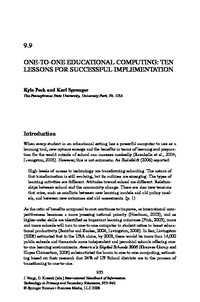One-to-One Educational Computing: Ten Lessons for Successful ImplementationKyle Peck, Karl Sprenger
Zu finden in: International Handbook of Information Technology in Primary and Secondary Education (Seite 935 bis 942), 2009
|
 |
 Diese Seite wurde seit 12 Jahren inhaltlich nicht mehr aktualisiert.
Unter Umständen ist sie nicht mehr aktuell.
Diese Seite wurde seit 12 Jahren inhaltlich nicht mehr aktualisiert.
Unter Umständen ist sie nicht mehr aktuell.
 Zusammenfassungen
Zusammenfassungen
 When every student in an educational setting has a powerful computer to use as a learning tool, new options emerge and the benefits in terms of learning and preparation for the world outside of school can increase markedly (Roschelle et al., 2004; Livingston, 2006). However, this is not automatic. As Bielefeldt (2006) reported: High levels of access to technology are transforming schooling. The nature of that transformation is still evolving, but its outlines are emerging. The types of learning activities are different. Attitudes toward school are different. Relationships between school and the community change. There are also new tensions that arise, such as conflicts between new learning models and old policy models, and between new outcomes and old assessments. (p. 1)
When every student in an educational setting has a powerful computer to use as a learning tool, new options emerge and the benefits in terms of learning and preparation for the world outside of school can increase markedly (Roschelle et al., 2004; Livingston, 2006). However, this is not automatic. As Bielefeldt (2006) reported: High levels of access to technology are transforming schooling. The nature of that transformation is still evolving, but its outlines are emerging. The types of learning activities are different. Attitudes toward school are different. Relationships between school and the community change. There are also new tensions that arise, such as conflicts between new learning models and old policy models, and between new outcomes and old assessments. (p. 1)As the ratio of benefits compared to cost continues to improve, as international competitiveness becomes a more pressing national priority (Friedman, 2005), and as higher-order skills are identified as important learning outcomes (Pink, 2005), more and more schools will turn to one-to-one computer to student ratios to boost educational productivity (Bonifaz and Zucker, 2004; Livingston, 2006). In fact, Livingston (2006) estimated that in the USA alone, by 2006, there would be more than 14,000 public schools and thousands more independent and parochial schools offering one-to-one learning environments. America´s Digital Schools 2006 (Greaves Group and Hayes Connection, 2006) substantiated the boom in one-to-one computing, estimating based on their research that 24% of US School districts are in the process of transitioning to one-to-one.
 Dieses Kapitel erwähnt ...
Dieses Kapitel erwähnt ...
 Begriffe KB IB clear |  Computer Computer computer
, computer
,  Lernen Lernen learning
, One-to-One-ComputingOne-to-One-Computing
, learning
, One-to-One-ComputingOne-to-One-Computing
,  Schule Schule school school
|
 Dieses Kapitel erwähnt vermutlich nicht ...
Dieses Kapitel erwähnt vermutlich nicht ... 
 Nicht erwähnte Begriffe | Bildung, Digitalisierung, Ein Notebook pro StudentIn (ENpS), Kinder, LehrerIn, Notebooks an Schulen, Unterricht |
 Tagcloud
Tagcloud
 Anderswo finden
Anderswo finden
 Volltext dieses Dokuments
Volltext dieses Dokuments
 |  One-to-One Educational Computing: Ten Lessons for Successful Implementation: Artikel als Volltext bei Springerlink ( One-to-One Educational Computing: Ten Lessons for Successful Implementation: Artikel als Volltext bei Springerlink ( : :  , 144 kByte; , 144 kByte;  : :  2020-11-28) 2020-11-28) |
 Anderswo suchen
Anderswo suchen 
 Beat und dieses Kapitel
Beat und dieses Kapitel
Beat hat Dieses Kapitel während seiner Zeit am Institut für Medien und Schule (IMS) ins Biblionetz aufgenommen. Er hat Dieses Kapitel einmalig erfasst und bisher nicht mehr bearbeitet. Beat besitzt kein physisches, aber ein digitales Exemplar. Eine digitale Version ist auf dem Internet verfügbar (s.o.). Aufgrund der wenigen Einträge im Biblionetz scheint er es nicht wirklich gelesen zu haben. Es gibt bisher auch nur wenige Objekte im Biblionetz, die dieses Werk zitieren.










 Biblionetz-History
Biblionetz-History